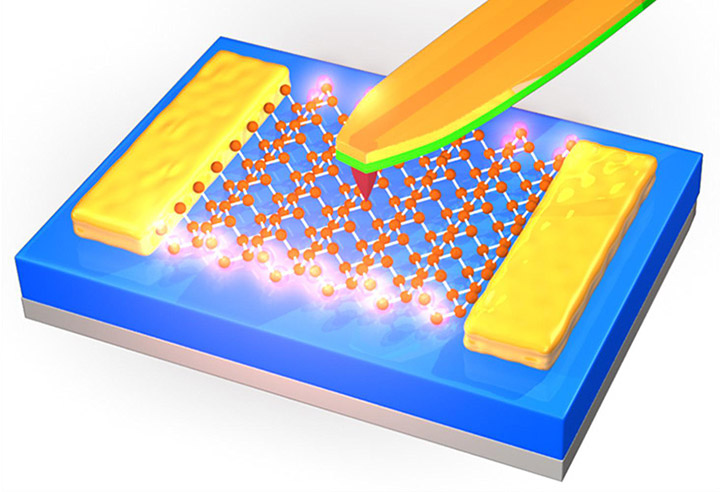Peering into atomically thin transistors with microwaves, scientists make a radical discovery: a one-dimensional transistor
July 18, 2016

Peering into an atomically thin semiconductor device with a “microwave microscope” via an AFM tip (credit: University of Texas at Austin)
Physicists at The University of Texas at Austin have had the first-ever glimpse into what happens inside an atomically thin semiconductor device. In doing so, they discovered that a transistor may be possible within a space so small (the edge) that it’s effectively one-dimensional.
Future tech innovations will require finding a way to fit more transistors on computer chips to keep up with Moore’s law, so experts have begun exploring new semiconducting materials, including one called molybdenum disulfide (MoS2), as KurzweilAI reported last week. In a paper published July 18 in the Proceedings of the National Academy of Sciences, the researchers describe seeing the detailed inner workings of this new type of two-dimensional transistor.
Unlike today’s silicon-based devices, transistors made from MoS2 allow for on-off signaling on a single 2-D (flat) plane.
Computing on a one-dimensional edge
Keji Lai*, an assistant professor of physics, and his team used a “microwave impedance microscope” that he invented and that pointed microwaves at the 2-D device. Using an atomic force microscope (AFM) tip only 100 nanometers wide, the microwave microscope allowed the scientists to see conductivity changes inside the transistor for the first time.
That’s when they discovered that with MoS2, the conductive signaling happens much differently than with silicon — in a way that could promote future energy savings in devices.
With silicon transistors, the entire device is either turned on or off. With 2-D transistors, by contrast, Lai and the team found that electric currents move in a more phased (or wave-like) way, beginning first at the edges before appearing in the interior. Lai says this suggests the same current could be sent with less power and in an even tinier space — using a one-dimensional edge (a line) instead of the two-dimensional plane (area).
“In physics, edge states often carry a lot of interesting phenomena, and here, they are the first to turn on. In the future, if we can engineer this material very carefully, then these edges can carry the full current,” Lai says. “We don’t really need the entire thing, because the interior is useless. Just having the edges running to get a current working would substantially reduce the power loss.”
Eliminating defects
Researchers have been working to get a view into what happens inside a 2-D transistor for years to better understand both the potential and the limitations of the new materials. Getting 2-D transistors ready for commercial devices, such as paper-thin computers and cellphones, is expected to take several more years. Lai says scientists need more information about what interferes with performance in devices made from the new materials.
Besides seeing the currents’ motion, the scientists found thread-like defects in the middle of the transistors. Lai says this suggests the new material will need to be made cleaner to function optimally. “If we could make the material clean enough, the edges will be carrying even more current, and the interior won’t have as many defects,” Lai says.
The research was supported by the U.S. Department of Energy, the Welch Foundation, the Office of Naval Research, and the National Science Foundation.
* Earlier this year, Lai and co-researcher Deji Akinwande, associate professor of UT Austin’s Department of Electrical and Computer Engineering, won Presidential Early Career Awards for Scientists and Engineers, the U.S. government’s highest honor for early-stage scientists and engineers.
UT | In this visualization of what happens inside a 2-D transistor made of a promising new material called MoS2, electric currents appear initially at the outer edges and then inside of the device. Thread-like flaws can be seen in the interior part of the transistor.
Abstract of Uncovering edge states and electrical inhomogeneity in MoS2 field-effect transistors
The understanding of various types of disorders in atomically thin transition metal dichalcogenides (TMDs), including dangling bonds at the edges, chalcogen deficiencies in the bulk, and charges in the substrate, is of fundamental importance for TMD applications in electronics and photonics. Because of the imperfections, electrons moving on these 2D crystals experience a spatially nonuniform Coulomb environment, whose effect on the charge transport has not been microscopically studied. Here, we report the mesoscopic conductance mapping in monolayer and few-layer MoS2 field-effect transistors by microwave impedance microscopy (MIM). The spatial evolution of the insulator-to-metal transition is clearly resolved. Interestingly, as the transistors are gradually turned on, electrical conduction emerges initially at the edges before appearing in the bulk of MoS2 flakes, which can be explained by our firstprinciples calculations. The results unambiguously confirm that the contribution of edge states to the channel conductance is significant under the threshold voltage but negligible once the bulk of the TMD device becomes conductive. Strong conductance inhomogeneity, which is associated with the fluctuations of disorder potential in the 2D sheets, is also observed in the MIM images, providing a guideline for future improvement of the device performance.